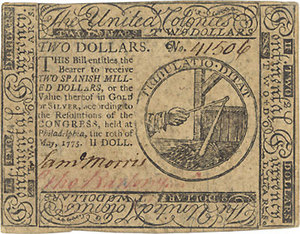In the summer of 1775 the 13 colonies that would become the United States of America found itself embroiled in a war with England. The shot heard round the world had been fired at Lexington, Massachusetts, and battles had also been fought in Concord and Bunker Hill. The Declaration of Independence was still a year away, but the Continental Congress realized that if they were to continue engaging in this war they were going to need money.
The Continental Congress decided upon a simple strategy to pay for the war against England: they would just print up some money and expect people to accept it. And so it was that on the 23rd of June, 1775, the Continental Congress printed out $2,000,000 worth of money. The bills they printed soon became known as Continentals, since they were printed by the Continental Congress.
At first everything went fine with the new currency. The people were told that once the war was over the Continental Congress would take the money back in taxes and it would be retired, thus ensuring its stability. Patriotic colonists gladly accepted the money, and it seemed that all was well.
Unfortunately all was not well. $2,000,000 didn’t last very long for the Continental Congress, and so they decided to print some more money. And some more money. By the end of 1775 they had printed $6,000,000 worth of the new Continental currency.
Still, despite this continuous pumping of money into the colonies (it was estimated that there was only $12,000,000 worth of money in the colonies prior to the first printing of Continental currency, meaning by the end of 1775 they had already increased the money supply by 50%), things went along pretty well.
The problem was that the war did not go as well as the Continental Congress or the patriots among the colonists had hoped. It dragged on and on, year after year. As time wore on the Congress kept printing more and more money, while support for the Continental Congress and their currency grew less and less. On top of this counterfeiters began producing counterfeit bills, even more putting the stability of the currency in jeopardy.
By 1779 the effect was that $100 worth of specie (gold and silver coins, etc.) would buy you $2,600 worth of Continental currency. Two years later in 1781 $100 worth of real money would get you $16,800 worth of Continental paper money. By this time there was far in excess of $200,000,000 worth of Continental money floating around.
For the soldiers of the Continental Army who had been paid in Continental currency and the patriots who had continued to support the cause, the inflation was disastrous. After the war was over so many of these people found themselves terribly in debt, with paper money that was all but worthless (when they even got that).
Although the Continental dollar had succeeded in allowing the Continental Congress to wage its war which was ultimately victorious, the Continental currency was seen as a disaster by all. The common phrase “not worth a Continental” was inspired by the disaster, and it gave Americans for generations to come a strong bias against paper money, a bias held by many presidents throughout our history such as Thomas Jefferson and most famously Andrew Jackson, who believed his crowning achievement was his defeat of the Second National Bank. In fact Jackson has the words “I killed the Bank” engraved on his tombstone, he was so against the idea both of a central bank and the paper money they were so fond of printing.


